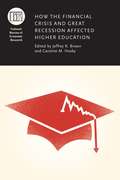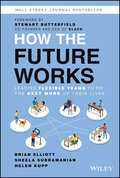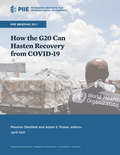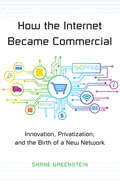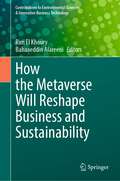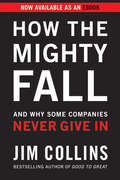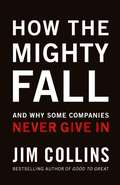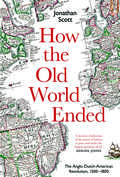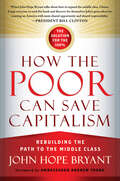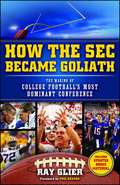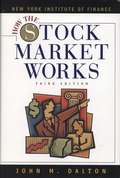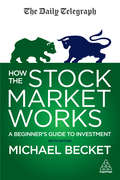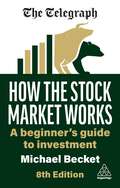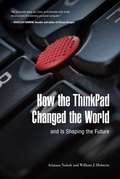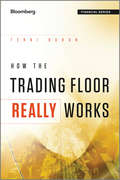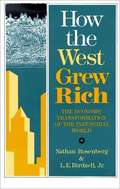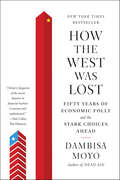- Table View
- List View
How the Financial Crisis and Great Recession Affected Higher Education (National Bureau of Economic Research Conference Report)
by Jeffrey R. Brown and Caroline M. HoxbyThe recent financial crisis had a profound effect on both public and private universities, which faced shrinking endowments, declining charitable contributions, and reductions in government support. Universities responded to these stresses in different ways. This volume presents new evidence on the nature of these responses, and on how the incentives and constraints facing different institutions affected their behavior. The studies in this volume explore how various practices at institutions of higher education, such as the drawdown of endowment resources, the awarding of financial aid, and spending on research, responded to the financial crisis. The studies examine universities as economic organizations that operate in a complex institutional and financial environment. The authors examine the role of endowments in university finances and the interaction of spending policies, asset allocation strategies, and investment opportunities. They demonstrate that universities’ behavior can be modeled using economic principles.
How the Future Works: Leading Flexible Teams To Do The Best Work of Their Lives
by Brian Elliott Sheela Subramanian Helen KuppUnlock the power of flexible work with this practical “how-to” guide from the leadership of Slack and Future Forum The way we work has changed. The era of toiling from nine-to-five, five-days-a-week in the office is now a relic of the past, and is being replaced by a better way—flexible work. But flexibility means a lot more than a day or two a week to “work from home”: 93% of your employees want more flexibility in when, not just where, they work. They want choice and they are leaving their roles to find it. The most successful leaders will go much further than offering occasional remote workdays—they will redesign every aspect of how work gets done, from defining how they measure organizational success to training their managers to make it happen. How the Future Works: Leading Flexible Teams to Do The Best Work of Their Lives offers a blueprint for using flexible work to unlock the potential of your people. The book offers the steps necessary to building the new principles and guardrails to empower flexible, high-performing teams. And it teaches readers to lead with purpose, to manage and measure differently, and to believe that by letting go, they’ll get more back than they thought possible. How the Future Works explains how to: Establish leadership principles, commitments, and outcomes for truly flexible teamwork Measure and assess productivity in a flexible workplace Reskill managers to ensure a level playing field for all employees Implement the infrastructure necessary to make flexible work successful Using original research from Future Forum, a consortium by Slack, and global case studies from leading companies such as Levi Strauss & Co., Genentech, Royal Bank of Canada, and IBM, How the Future Works offers concrete solutions and practical steps for building high functioning teams of talented, engaged people by providing them with the flexibility and choice they need to do their best work.
How the G20 Can Hasten Recovery from COVID-19
by Maurice Obstfeld Adam S. PosenThe world's leading economic powers must cooperate more to combat the health and economic shocks resulting from the COVID-19 pandemic. In a new free eBook, PIIE Briefing, How the G20 can hasten recovery from COVID-19, Peterson Institute experts outline how collective action by the Group of Twenty (G20) nations can make a difference. The PIIE agenda includes removal of trade barriers impeding the flow of medical supplies and food, and more money for research, testing, and disease control, especially for debt-burdened low-income countries. The World Bank and the World Health Organization need more resources to relieve suffering, and the International Monetary Fund must step up to stabilize the world financial system.
How the Internet Became Commercial
by Shane GreensteinIn less than a decade, the Internet went from being a series of loosely connected networks used by universities and the military to the powerful commercial engine it is today. This book describes how many of the key innovations that made this possible came from entrepreneurs and iconoclasts who were outside the mainstream--and how the commercialization of the Internet was by no means a foregone conclusion at its outset.Shane Greenstein traces the evolution of the Internet from government ownership to privatization to the commercial Internet we know today. This is a story of innovation from the edges. Greenstein shows how mainstream service providers that had traditionally been leaders in the old-market economy became threatened by innovations from industry outsiders who saw economic opportunities where others didn't--and how these mainstream firms had no choice but to innovate themselves. New models were tried: some succeeded, some failed. Commercial markets turned innovations into valuable products and services as the Internet evolved in those markets. New business processes had to be created from scratch as a network originally intended for research and military defense had to deal with network interconnectivity, the needs of commercial users, and a host of challenges with implementing innovative new services.How the Internet Became Commercial demonstrates how, without any central authority, a unique and vibrant interplay between government and private industry transformed the Internet.
How the Metaverse Will Reshape Business and Sustainability (Contributions to Environmental Sciences & Innovative Business Technology)
by Bahaaeddin Alareeni Rim El KhourySustainability is part of every aspect of our life, with climate concerns shaping the future. Thus, it is important to understand how metaverse will affect sustainability, as it is opening both challenges and opportunities for environmental sustainability. On the one side, replacing real-world interactions with 3D virtual and exchanging physical goods with digital ones are significantly less resource-intensive and more carbon-efficient. Therefore, this holds the promise of reducing the environmental pollution. On the other side, metaverse increases e-waste and energy consumption. Given this controversial impact, it is crucial for businesses and researchers to understand how to ensure that the metaverse develops sustainably. This book is popping out several questions: Do businesses understand the metaverse concept and perceive the benefits and advantages of implementing such technologies? How will the metaverse change business? Will metaverse change our working place and skills needed? How can companies get ahead of the change and mold it to their advantage? Will businesses use metaverse? Can metaverse create a more sustainable word? How can we make the metaverse better than what we have now? Is it going to affect environmental sustainability? Will it cause more severe climate problems, or would it be the solution? How can metaverse impact the achievements of SDGs?
How the Mighty Fall
by Jim CollinsDecline can be avoided. Decline can be detected. Decline can be reversed. Amidst the desolate landscape of fallen great companies, Jim Collins began to wonder: How do the mighty fall? Can decline be detected early and avoided? How far can a company fall before the path toward doom becomes inevitable and unshakable? How can companies reverse course? In How the Mighty Fall, Collins confronts these questions, offering leaders the well-founded hope that they can learn how to stave off decline and, if they find themselves falling, reverse their course. Collins' research project-more than four years in duration-uncovered five step-wise stages of decline: Stage 1: Hubris Born of Success Stage 2: Undisciplined Pursuit of More Stage 3: Denial of Risk and Peril Stage 4: Grasping for Salvation Stage 5: Capitulation to Irrelevance or Death By understanding these stages of decline, leaders can substantially reduce their chances of falling all the way to the bottom. Great companies can stumble, badly, and recover. Every institution, no matter how great, is vulnerable to decline. There is no law of nature that the most powerful will inevitably remain at the top. Anyone can fall and most eventually do. But, as Collins' research emphasizes, some companies do indeed recover-in some cases, coming back even stronger-even after having crashed into the depths of Stage 4. Decline, it turns out, is largely self-inflicted, and the path to recovery lies largely within our own hands. We are not imprisoned by our circumstances, our history, or even our staggering defeats along the way. As long as we never get entirely knocked out of the game, hope always remains. The mighty can fall, but they can often rise again.
How the Mighty Fall
by Jim CollinsDecline can be avoided. Decline can be detected. Decline can be reversed. Amidst the desolate landscape of fallen great companies, Jim Collins began to wonder: How do the mighty fall? Can decline be detected early and avoided? How far can a company fall before the path toward doom becomes inevitable and unshakable? How can companies reverse course? In How the Mighty Fall, Collins confronts these questions, offering leaders the well-founded hope that they can learn how to stave off decline and, if they find themselves falling, reverse their course. Collins' research project--more than four years in duration--uncovered five step-wise stages of decline: Stage 1: Hubris Born of Success Stage 2: Undisciplined Pursuit of More Stage 3: Denial of Risk and Peril Stage 4: Grasping for Salvation Stage 5: Capitulation to Irrelevance or Death By understanding these stages of decline, leaders can substantially reduce their chances of falling all the way to the bottom. Great companies can stumble, badly, and recover. Every institution, no matter how great, is vulnerable to decline. There is no law of nature that the most powerful will inevitably remain at the top. Anyone can fall and most eventually do. But, as Collins' research emphasizes, some companies do indeed recover--in some cases, coming back even stronger--even after having crashed into the depths of Stage 4. Decline, it turns out, is largely self-inflicted, and the path to recovery lies largely within our own hands. We are not imprisoned by our circumstances, our history, or even our staggering defeats along the way. As long as we never get entirely knocked out of the game, hope always remains. The mighty can fall, but they can often rise again.
How the Mighty Fall: And Why Some Companies Never Give In
by Jim CollinsDecline can be avoided. Decline can be detected. Decline can be reversed. Amidst the desolate landscape of fallen great companies, Jim Collins began to wonder: How do the mighty fall? Can decline be detected early and avoided? How far can a company fall before the path toward doom becomes inevitable and unshakable? How can companies reverse course? In How the Mighty Fall, Collins confronts these questions, offering leaders the well-founded hope that they can learn how to stave off decline and, if they find themselves falling, reverse their course. Collins' research project-more than four years in duration-uncovered five step-wise stages of decline: Stage 1: Hubris Born of Success, Stage 2: Undisciplined Pursuit of More, Stage 3: Denial of Risk and Peril, Stage 4: Grasping for Salvation, Stage 5: Capitulation to Irrelevance or Death. By understanding these stages of decline, leaders can substantially reduce their chances of falling all the way to the bottom. Great companies can stumble, badly, and recover. Every institution, no matter how great, is vulnerable to decline. There is no law of nature that the most powerful will inevitably remain at the top. Anyone can fall and most eventually do. But, as Collins' research emphasizes, some companies do indeed recover--in some cases, coming back even stronger-even after having crashed into the depths of Stage 4. Decline, it turns out, is largely self-inflicted, and the path to recovery lies largely within our own hands. We are not imprisoned by our circumstances, our history, or even our staggering defeats along the way. As long as we never get entirely knocked out of the game, hope always remains. The mighty can fall, but they can often rise again.
How the Net Promoter Score (NPS) Can Drive Growth: The Economic Advantage of Superior Customer Relationships
by Fred ReichheldCompanies need to understand the economic value that results from building better customer relationships. This chapter looks at some real-life examples of high-quality customer relationships generating economic benefits. This chapter was originally published as Chapter 3 of "The Ultimate Question: Driving Good Profits and True Growth."
How the Old World Ended: The Anglo-Dutch-American Revolution 1500-1800
by Jonathan ScottA magisterial account of how the cultural and maritime relationships between the British, Dutch and American territories changed the existing world order – and made the Industrial Revolution possible Between 1500 and 1800, the North Sea region overtook the Mediterranean as the most dynamic part of the world. At its core the Anglo-Dutch relationship intertwined close alliance and fierce antagonism to intense creative effect. But a precondition for the Industrial Revolution was also the establishment in British North America of a unique type of colony – for the settlement of people and culture, rather than the extraction of things. England&’s republican revolution of 1649–53 was a spectacular attempt to change social, political and moral life in the direction pioneered by the Dutch. In this wide-angled and arresting book Jonathan Scott argues that it was also a turning point in world history. In the revolution&’s wake, competition with the Dutch transformed the military-fiscal and naval resources of the state. One result was a navally protected Anglo-American trading monopoly. Within this context, more than a century later, the Industrial Revolution would be triggered by the alchemical power of American shopping
How the Other Half Banks: Exclusion, Exploitation, and the Threat to Democracy
by Mehrsa BaradaranThe United States has two separate banking systems--one serving the well-to-do and another exploiting everyone else. Deserted by banks and lacking credit, many people are forced to wander through a Wild West of payday lenders and check-cashing services thanks to the effects of deregulation in the 1970s that continue today, Mehrsa Baradaran shows.
How the Other Half Works: Immigration and the Social Organization of Labor
by Michael I. Lichter Roger WaldingerA beautifully written, clear portrait of how low-skilled workers in Los Angeles get jobs in six industries (department stores, restaurants, printing, hospitals, hotels, and furniture manufacturing). Grounded in the best research and interviews with more than 200 employers, this book show us the human dynamics behind the statistics.
How the Poor Can Save Capitalism: Rebuilding the Path to the Middle Class
by John Hope BryantJohn Hope Bryant, successful self-made businessman and founder of the nonprofit Operation HOPE, says business and political leaders are ignoring the one force that could truly re-energize the stalled American economy: the poor. If we give poor communities the right tools, policies, and inspiration, he argues, they will be able to lift themselves up into the middle class and become a new generation of customers and entrepreneurs. Raised in poverty-stricken, gang-infested South Central Los Angeles, Bryant saw firsthand how our institutions have abandoned the poor. He details how business loans, home loans, and financial investments have vanished from their communities. After decades of deprivation, the poor lack bank accounts, decent credit scores, and any real firsthand experience of how a healthy free enterprise system functions. Bryant radically redefines the meaning of poverty and wealth. (It's not just a question of finances; it's values too.) He exposes why attempts to aid the poor so far have fallen short and offers a way forward: the HOPE Plan, a series of straightforward, actionable steps to build financial literacy and expand opportunity so that the poor can join the middle class. Fully 70 percent of the American economy is driven by consumer spending, but more and more people have too much month at the end of their money. John Hope Bryant aspires to "expand the philosophy of free enterprise to include all of God's children" and create a thriving economy that works not just for the 1 percent or even the 99 percent but for the 100 percent. This is a free enterprise approach to solving the problem of poverty and raising up a new America.
How the SEC Became Goliath
by Ray GlierHow the SEC Became Goliath covers the Southeastern Conference and how the league became dominant in college football, winning six straight national championships. Size matters. That's why the SEC is Goliath, because the Southeastern Conference, top to bottom, has better coaches, better stadiums, better bank accounts, and better weather, but the real difference maker is the bigger and better players. For six straight years the SEC has walked off with the big crystal prize and will not give it back. The talk of "big boy football" grinds on the Buckeyes, Sooners, Longhorns, and Ducks. All they can come back with is "Wait until next year." Then next year comes and the SEC tribe is chanting in the closing minutes of the National Championship Game, "SEC, SEC, SEC!" The national championship trophy has been in the South for so long it has sunburn. That is why college football is thick with the acrimony: SEC vs. Everyone Else. The dominance of the SEC has a lot more to do with the South's culture than just the rock-'em, sock-'em of football played one day a week. The South lost the Civil War, and sociologists will tell you that there is still a regional angst, an "us against them" mentality, a spirit of "those damn Yankees." It is not just about championships. The SEC is about culture and competitiveness. . . . It is about players. *** How the SEC Became Goliath provides an inside look at college football's most dominant conference. Four different schools in the SEC have won the last six championship titles: Florida vs. Ohio State in 2006 January 8, 2007 * The Zook-Meyer Gators embarrass the Big Ten. Florida 41 Ohio State 14 LSU vs. Ohio State in 2007 January 7, 2008 * Unbeaten in regulation, the Tigers are good . . . and lucky. LSU 38 Ohio State 24 Florida vs. Oklahoma in 2008 January 8, 2009 * One of the best teams in history, these Gators are all Meyer's. Florida 24 Oklahoma 14 Alabama vs. Texas in 2009January 7, 2010 * The Tide make it four in a row for the SEC.Alabama 37 Texas 21 Auburn vs. Oregon in 2010 January 10, 2011 * Cam Newton and Auburn cap a perfect season. Auburn 22 Oregon 19 Alabama vs. LSU in 2011 January 9, 2012 * Saban wins his third title and the SEC makes it six in a row. Alabama 21 LSU 0
How the Stock Market Works
by Michael BecketNow more than ever, people are being affected by the fluctuations in the global economy and by financial uncertainty - with major impacts on their savings, portfolios and pensions. Fully updated for this fourth edition, How the Stock Market Works tells investors what is being traded and how, who does what with whom, and how to evaluate a particular share or bond in light of rival claims from critics and admirers. From the practical consequences of being a shareholder to a basic coverage of the taxation regime, the book provides a wealth of information on individual product types as well as the key players themselves.
How the Stock Market Works
by Michael BecketNow more than ever, people are being affected by the fluctuations in the global economy and by financial uncertainty - with major impacts on their savings, portfolios and pensions. Fully updated for this fifth edition, How the Stock Market Works tells investors what is being traded and how, who does what with whom, and how to evaluate a particular share or bond in light of rival claims from critics and admirers. From the practical consequences of being a shareholder to a basic coverage of the taxation regime, the book provides a wealth of information on individual product types as well as the key players themselves.
How the Stock Market Works (3rd Edition)
by John M. DaltonDescribes market structures and trading techniques. Written for the beginner.
How the Stock Market Works: A Beginner's Guide to Investment
by Michael BecketSo just how does the investment industry really work?Now more than ever, people are being affected by the fluctuations in the global economy and by financial uncertainty - with major impacts on their savings, portfolios and pensions. It takes not just savvy but real information to maintain financial security and safeguard one's future. Consequently, it is now more important than ever to understand how the markets work and what choices are available. Fully updated for this sixth edition, How the Stock Market Works tells investors what is being traded and how, who does what with whom, and how to evaluate a particular share or bond in light of rival claims from critics and admirers. From the practical consequences of being a shareholder to a basic coverage of the taxation regime, this book provides a wealth of information on individual product types as well as the key players themselves.It may not take a genius to make a fortune, but anyone considering investing in the stock market will need care, common sense, lots of luck - and the expert advice of How the Stock Market Works.
How the Stock Market Works: A Beginner's Guide to Investment
by Michael BecketDo you want to understand investing but are not sure where to start? Get to grips with everything you need to know about the UK's investment and financial markets with this bestselling guide.Knowing how to invest can feel overwhelming. How the Stock Market Works gives you concise and practical information breaking down complex jargon, so you can get started. Economic uncertainty and rapidly changing global events can have a significant impact on your investments, pension and retirement. It's all the more important to truly grasp how the financial markets work so you can make informed decisions about your personal finances. This fully updated bestselling eighth edition of How the Stock Market Works provides you with all the tools needed to understand investing with new sections on ethical investing, emerging markets, trends in the bond market and the UK's place in the global economy post-Brexit. Starting with the basics of shares, bonds, gilts and derivatives, this guide explains how to find reliable advice, the tricks of the professionals and how and when to trade in shares, so you take control of your investments and future.
How the Stock Markets Work: Fully Revised and Updated Ninth Edition
by Colin ChapmanHow the Stock Markets Work has long been an established favourite for anyone who needs a straightforward, accessible introduction to the stock markets. This guide concisely explains how the stock markets have developed as well as how they operate today and is a must-buy for anyone looking to learn more about this sector of the financial industry.This new edition has been updated and revised throughout.
How the ThinkPad Changed the World—and Is Shaping the Future
by William Holstein Arimasa NaitohThe ThinkPad notebook computer has been at the center of the digital revolution that has transformed millions of lives around the world, allowing users to obtain access to their documents, pictures and other personal data from virtually anywhere at any time. More than 100 million ThinkPads have been sold since they were introduced in 1992, some twenty-five years ago. ThinkPads played a prominent role in NASA's space exploration and at the International Space Station. They accompanied explorers who traversed the entire length of the Nile River and conquered Mount Everest. ThinkPads also played a major role in changing the very architecture of how humanity's knowledge is stored and made available.In this book, Arimasa Naitoh, the father of the ThinkPad, collaborates with American business journalist and author William J. Holstein to write candidly about the incredible technological and personal struggles he and fellow engineers faced. And he offers his vision of the future of mobile computing—because this revolution is not even close to being finished.
How the Trading Floor Really Works
by Terri DuhonA detailed look at what really happens in the front office of an investment bank and whyTrading floors have always fascinated people, but few understand the role they play in the world of finance today. Though markets rise and fall every day, the drivers of those are rarely explored. Those who understand the dynamics of trading floors will better understand the dynamics of global financial markets. This book reveals the key players on the floor, their roles and responsibilities, how they serve their clients, and how it all impacts the markets. It also explains important terminology, explains the world of trading both cash and derivatives, and much more.Includes a foreword by Gillian Tett, author of Fool's Gold: How Unrestrained Greed Corrupted a Dream, Shattered Global Markets and Unleashed a Catastrophe.Terri Duhon (www.terriduhon.co) is a financial market expert who in 2004 founded B&B Structured Finance Ltd, which provides expert consulting and financial markets training . Her time on the trading floor has been documented in the book Fool's Gold as well as by PBS's Frontline.
How the West Grew Rich: The Economic Transformation of the Industrial World
by Nathan Rosenberg L. E. BirdzellHow did the West—Europe, Canada, and the United States—escape from immemorial poverty into sustained economic growth and material well-being when other societies remained trapped in an endless cycle of birth, hunger, hardship, and death? In this elegant synthesis of economic history, two scholars argue that it is the political pluralism and the flexibility of the West's institutions—not corporate organization and mass production technology—that explain its unparalleled wealth.
How the West Was Lost
by Dambisa MoyoA bold account of the decline of the West's economic supremacy and radical solutions to reverse the drift.Bestselling author Dambisa Moyo gives a fresh insider's perspective on the erosion of Western power over the past 50 years. She examines how the West's flawed financial decisions and blinkered political and military choices have resulted in an economic and geopolitical seesaw that is now poised to favour the emerging world.Moyo is uniquely positioned to examine the West's errors and the techniques the emerging countries used to rise on the global economic stage:As a former economist and banker she gives a new perspective on the dramatic shifts in the global economyHer "Wall Street" vantage point captures the nuances of what role the financial sector had in the decline of Western powerHer world view as someone neither from the West nor from any of the emerging countries produces an unbiased, non-Western analysisMoyo daringly claims that the West can no longer afford to regard the up-and-comers simply as menacing gatecrashers and proposes radical solutions it needs to adopt in order to reassert itself as a global economic power.
How the West Was Lost: Fifty Years of Economic Folly and the Stark Choices Ahead
by Dambisa MoyoIn How the West Was Lost, the New York Times bestselling author Dambisa Moyo offers a bold account of the decline of the West's economic supremacy. She examines how the West's flawed financial decisions have resulted in an economic and geopolitical seesaw that is now poised to tip in favor of the emerging world, especially China. Amid the hype of China's rise, however, the most important story of our generation is being pushed aside: America is not just in economic decline, but on course to become the biggest welfare state in the history of the West. The real danger is at home, Moyo claims. While some countries – such as Germany and Sweden – have deliberately engineered and financed welfare states, the United States risks turning itself into a bloated welfare state not because of ideology or a larger vision of economic justice, but out of economic desperation and short-sighted policymaking.How the West Was Lost reveals not only the economic myopia of the West but also the radical solutions that it needs to adopt in order to assert itself as a global economic power once again.
